Driving In France: Tips From An American!
Dreaming of a little French road trip through fields of lavender?
I navigated the highways and little village roads of southern France for a little over a month, and not only did I fall in love with the countryside, but I also discovered a more authentic France than I otherwise would have without a car.
Driving in France is quite fun and easy, but there were a few things that threw me for a loop – roundabouts, “Priorité à Droite“, and some really aggressive French drivers – who would have thought?!
This guide is my lessons learned, and go-to resource for driving in France. I’ll dive into the details of everything from what type of car is best to rent, license requirements, tolls, how parking works, the weirder traffic rules, how to navigate the different types of roads, how to handle crazy French drivers, and how to basically make the most of your trip.
Quick Hitters: Driving In France
✔️ I rent cars with DISCOVER CARS because they have the best deals. The roads are narrow – for the love of baby Jesus, rent a small car!
✔️ Weird Laws: there are special “yield to the right“, and “no turn on red” laws, as well as a certain way to overtake that is different in France compared to the States.
✔️ You can drive in France with a US License, but you will want to get an International Driver’s Permit as well.
✔️ Park outside of the little French villages so you don’t get your car stuck on small French roads.
✔️ Drive defensively and be careful of randos pulling out in front of you.
Because the best places to visit in France are off the beaten path, renting a car is a must (except in Paris).
Driving In France: License Requirements
You will need your passport, U.S. license, and an International Driver’s Permit (IDP) to rent a car in France.
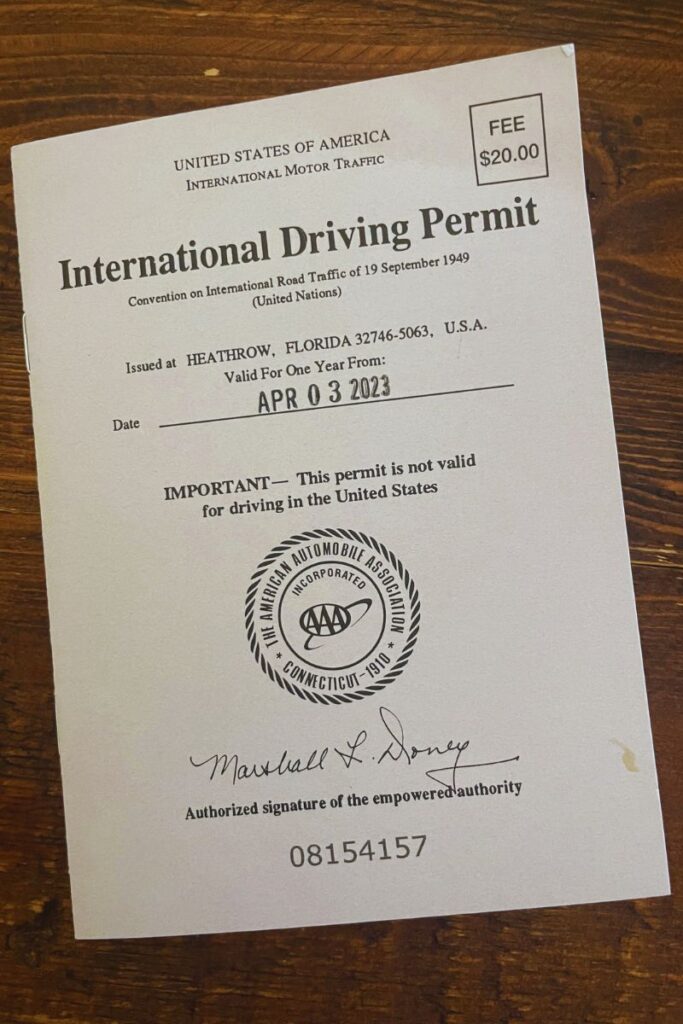
PRO TIP: I don’t carry my passport with me when I drive in France, just a copy, in case the police stop me.
An International Driver’s Permit is a small booklet that translates your U.S. driver’s license into multiple languages. Why do you need it? Well, if you’re pulled over or in an accident, the IDP makes it easier for local authorities to get your info. Plus, many car rental companies I rented from in France won’t hand over the keys without one.
Getting an IDP is easy. Just head to your local AAA office, fill out a simple form, show your U.S. driver’s license, and snap a couple of passport photos. There’s a $20 fee for all of this, and you’ll walk out with your IDP, valid for one year, in hand.
Renting A Car In France
Here are a few tips about renting a car to drive in France.
✅ Skip the Car in Big Cities
No need to rent a car or drive in big cities like Paris, Lyon, or Marseille. Public transportation is good, Uber is available when there’s a strike (which happens more frequently than in the US), and walking always works.
✅ Rent a Car to Explore Authentic France
I do recommend renting a car everywhere else in France. It gives you so much more freedom to explore off-the-beaten-path spots like vineyards, family restaurants, and villages that you see in all the Instagram pictures, not to mention some amazing nature spots all over the French countryside – the more authentic France.
This is what I personally use to check prices:
➡️ DISCOVER CARS ⬅️
You will want to get the insurance that goes along with the rental – I incurred a few nicks and scratches from a random tree branch I couldn’t squeeze past in Provence. 🙈
✅ Go Small & Pack Light
Cars in France are generally smaller. But I still recommend renting the smallest car you can so you can more easily navigate the small French roads and parking spots. Don’t let the car rental people upsell you on an SUV!
And pack light – if you’re more than 2 people with luggage, fitting everything into the back of a Citroën will be a struggle.
✅ Pumping Gas
There are three fuel grades 95-Octane, 98-Octane, and diesel (labeled diesel, gasoil, or gazole depending on the station). Your rental car keychain should indicate which one you need to pump. And for slower people like myself, it also says it on the little car gas door.
Crazy French Drivers
The moment the French grip the steering wheel, a transformation takes place. The sweet gentleman who held the door for you at the café now sees the open road as his own personal racetrack.
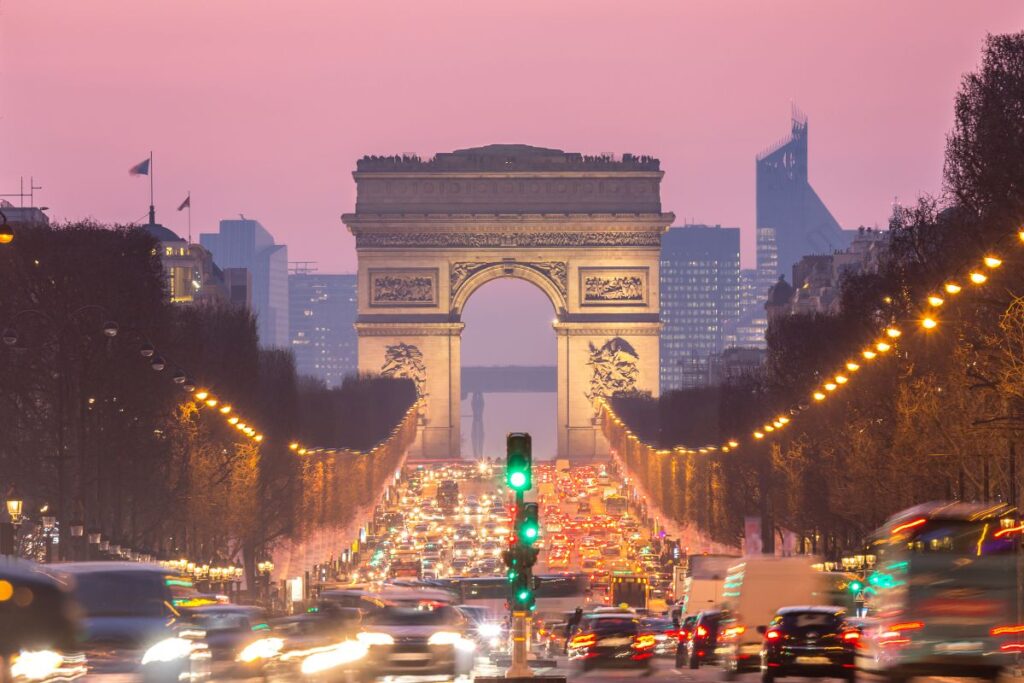
Roundabouts become a swirl of Peugeots and Renaults, each driver convinced of his leading role and priority, and small local roads fitting one car at a time become a battleground of who is the weakest link and needs to reverse first. But it’s on the autoroutes where the French driver truly comes alive. Foot heavy on the pedal, they zoom past you, flashing their lights, as if late for a rendezvous with Jesus himself!
Aggressive? Perhaps. But in France, driving is not merely a means to a destination — it’s an expression of one’s joie de vivre. And let me tell you, that joie is often expressed at speeds that would make a Formula 1 racer blush.
Types of Roads In France
Navigating French roads is a lot easier when you know what you’re dealing with. Here’s a quick rundown of the types of roads and their speed limits:
✔️ Autoroutes (Highways)
These are the speedy interstate highways and are usually multi-lane, well-managed, and easy to drive. It’s not the most scenic view, but it gets you across the country fast.
On a map, just like we have I-35 here in Austin, these autoroutes are labeled as A7 or A8, from Paris to Marseille for example. You can expect gas stations and rest areas more frequently on autoroutes.
The speed limit is 130 km/h (81 mph), drops to 110 km/h (68 mph) when it rains rain
PRO TIP: Missing an exit can mean a long detour—the next one might be 30 km away. It’s the only annoying thing about autoroutes.
You will have tolls on the autoroutes, which you can easily pay with cash or credit card. These tolls will be more expensive than tolls in the US, but such is life.
✔️ National Roads (Routes Nationales)
These are main roads with one lane in each direction, are super well-maintained, and have no tolls. These are what I drove on when I wanted to save money on tolls and didn’t really care about the extra 30 minutes it would cost me.
On a map, these roads are labeled as N8 and go from big cities to smaller cities, like Paris to Champagne.
The speed limit is 80-90 km/h (50-56 mph) on national roads. And watch for speed cameras – they are all over the place.
NOT SO FUN FACT: The rental company will send you speeding tickets at home a few months after your vacation – there’s no infraction that will get past the French speeding police! 🥲
✔️ Departmental Roads (Routes Départementales)
These are my favorite roads because they are the small French roads with the best views through vineyards, towns, and mountains. These are the roads that connect the small French villages, one lane in each direction, and great for exploring off-the-beaten-path spots.
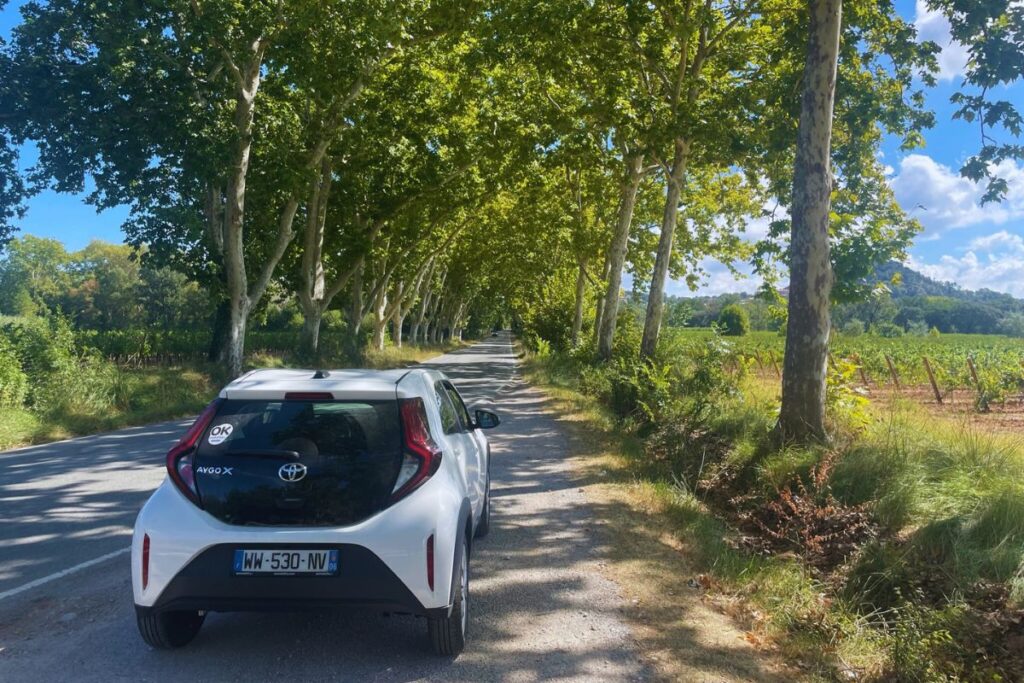
The speed limit on these is going to be about 80 km/h (50 mph), but I usually go slower, just in case some Frenchman is coming around a blind corner. Of if it’s too narrow for two cars to pass, and one of the cars (usually me) has to back up to let the other pass.
On a map, they are the D-304 roads, as an example, and create a wonderful web of road trip opportunities.
✔️ Local City Roads
These are the small little alleyways and roads in a city, where the speed limit drops to 50 km/h (31 mph). Speed limits can drop near schools and busy areas to about 30 km/h (19 mph), so just be careful.
Defensive slow driving in the cities and towns is key because there’s always a biker or little old lady coming out of nowhere trying to cross in front of you like they have Jesus on their side.
Paying Tolls In France
You’ll only see tolls on the highways (autoroutes) and all of them can be paid by cash or card. Just get in the lane that shows you the card or cash symbols – usually the middle and far right lanes.
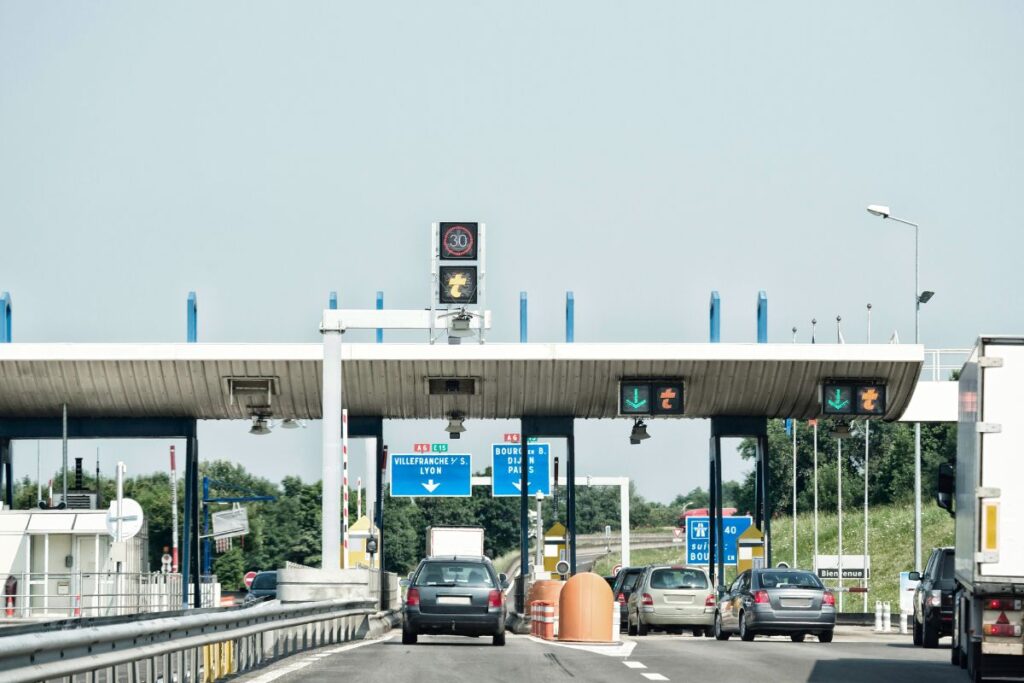
And if you’re shocked by the price of the tolls, 10-15 Euros for a couple of hours of driving on the highway, you’re not alone. I was too! Consider tolls the road tax for being in this beautiful country.
Speed Limits & Enforcement
Here’s a recap of the speed limits because I sure as hell did not see any speed limit signs in France. What I did see were speed cameras!
👉 NOTE: Watch yourself so you don’t get a surprise ticket in the mail from your rental car company – remember they still have your credit card!
Autoroutes (Highways)
- Speed Limit: 130 km/h (81 mph), drops to 110 km/h (68 mph) in rain
- What to Expect: Multi-lane, expensive tolls, frequent rest areas and gas stations
National Roads (Routes Nationales)
- Speed Limit: 80-90 km/h (50-56 mph)
- What to Expect: Main roads connecting cities, no tolls, one lane in each direction
Departmental Roads (Routes Départementales)
- Speed Limit: 80 km/h (50 mph)
- What to Expect: Smaller roads, often scenic routes, are my favorite!
Local City Roads
- Speed Limit: 50 km/h (31 mph)
- What to Expect: a clusterfuck to park on, sometimes cobblestone, sometimes one way only
Finding Parking
Parking in France is similar to everywhere else in Europe. There is no space for cars in small villages and most towns, so parking is usually right outside the town in a managed parking area or garage.
You can use Google to find parking garages almost anywhere- they are usually paid (not much) and a short walk away from the main town.
PRO TIP: If you park in a garage, you will have to validate the ticket before you leave. There is a kiosk at the entrance where you can do this – it’s not done at the gate when you exit like most places in the States.
Most parking on the street is also paid and is operated by a little automated kiosk that is associated with a parking app, so you can use both cash and credit card, put in your license place number, and go on your merry way!
⭐️ Special Traffic Laws ⭐️
It wouldn’t be an adventure if there weren’t a few random special laws to follow that are the exact opposite of driving at home. Here are the three that really stood out to me:
Yield to the Right or Priorité à Droite
In France, if you’re at an intersection without any road signs or signals, the vehicle coming from the right has the right of way. Yep, you read that right. Even if you’re cruising along a main road, you’ve got to hit the brakes for a car entering from a smaller road on your right – and they will, because the French are crazy! 😳
I thought this was a bit of a weird one, and dangerous to say the least, so I studied up on why the rule exists.
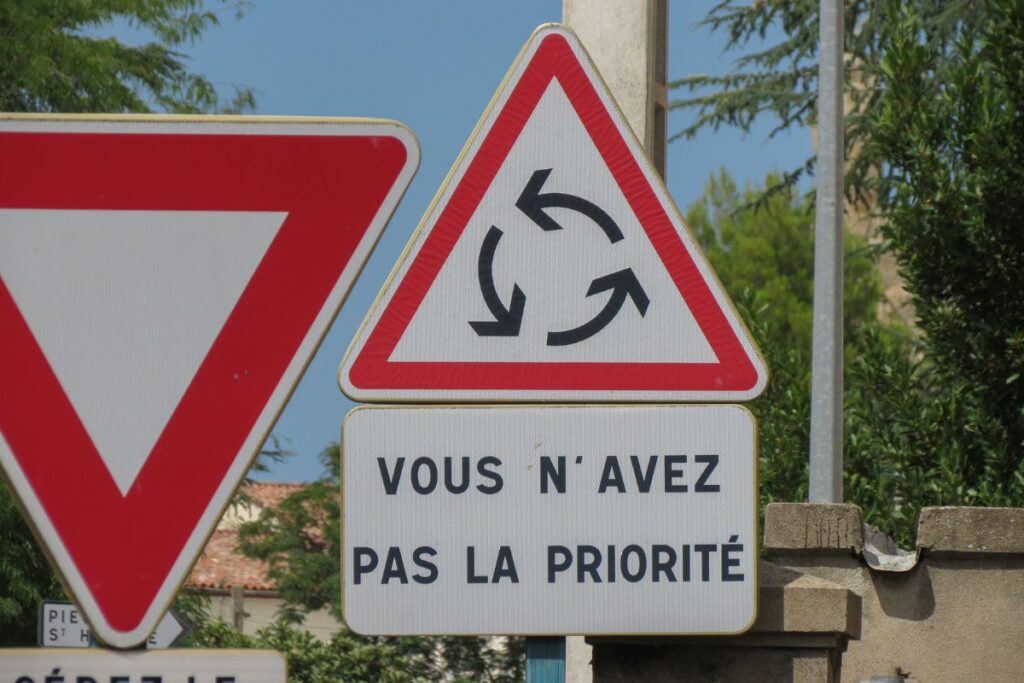
What I learned is this – it’s a bit of a historical relic, dating back to times when road signs were scarce. The idea was to regulate traffic at intersections in a straightforward way. It’s less common in modern France but still exists, especially in rural areas.
For you, this means always being on high alert at intersections. Don’t assume you can breeze through without checking for cars coming from the right. It’s a quick way to turn your scenic drive into a fender-bender—or worse.
NOTE: This rule doesn’t apply to roundabouts. There, it’s the cars already in the circle that have the right of way.
Just remember, when in doubt, yield to the right. Except in roundabouts.
No Right On Red
The “no turn on red” rule is an absolute curveball for American drivers in France. Unlike in the U.S., where a right turn on a red light is often fair game, in France, it’s a no-go.
The “no turn on red” rule is all about safety. The idea is to minimize the risk of accidents with pedestrians and cyclists, who might be crossing the street when you’re itching to make that turn. It also helps avoid conflicts with other vehicles coming from different directions.
So, when you’re at a red light in France, it’s a full stop, no exceptions. It might feel like a drag, especially if you’re used to the more lenient rules back home, but it’s a small adjustment for ensuring everyone’s safety on the road.
Drive Right, Pass Left
Maybe it’s just me, but when I drive in Texas, everyone is all over the place with no rhyme or reason as to which lane they stick to. I usually get on the highway in the States and make a beeline to the far left lane where I drive like a bat out of hell until it’s time for my exit. Don’t judge me, everyone does it!
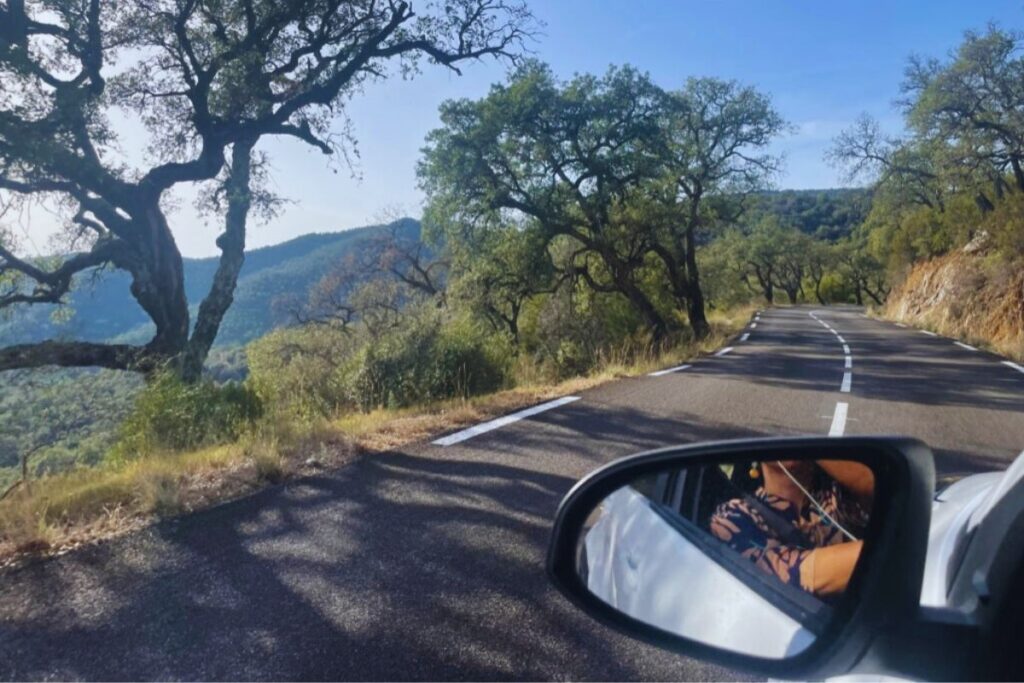
Well, in France (and driving in Europe in general), you drive on the far right lane until you want to pass. At this point, you get on the middle lane to pass. If you need to, and are a crazy mofo like me, you get on the farthest left lane to speed past everyone while you frantically check for speed cameras hidden in the trees.
Do not sit in the fast lane in France or you’ll have plenty of people ardently flashing their lights at you, flicking you off in a flowery French fashion, and tailgating your ass till you move out of the way. 🫠
Conclusion: Driving in France
All in all, I loved driving in France. It’s fun, and challenging sometimes, but the views are scenic, and the destinations are even more worth it! Here are the highlights:
✔️ International Drivers License Required: You do need an International Drivers License to rent a car.
✔️ Use Navigation Apps: Use Waze or Google Maps to navigate or you’ll get lost. Make sure your settings are correct—like “avoid tolls,” “highways only,” or “avoid city centers”. That last one was key for reducing anxiety.
✔️ Roundabout Etiquette: The roundabouts are civilized with priority to the cars in the circle — signal when you want to exit.
✔️ Autoroutes vs. Highways: In the States, if you miss an exit, you can easily turn around on the next overpass. In France, the next exit might be 30 km away, and the highways are not structured like in the US & Canada.
✔️ Fuel Up: Gas stations can be sparse in rural areas, so fill up when you can. Also most close at 9 pm and few are open on Sundays. Google can help you find the nearest open gas station.
✔️ Speed Cameras: Keep an eye on your speed to avoid fines – so many speed cameras.
✔️ Tolls: You can pay both cash and card at all tolls. Carry some cash with you, just in case the card reader doesn’t work.
✔️ Know the Signs: Signs are more or less the same. But familiarize yourself with French road signs for a smoother drive.
✔️ Aggressive Drivers: Be prepared for fast and aggressive drivers, especially on highways.
✔️ Overtaking: Always drive on the right and overtake on the left. The French are pretty civilized around this!
✔️ Parking Rules: Most parking is paid in France, at a little booth, which will work with apps, cards, or cash.
✔️ Cyclists: They are everywhere, treat them like a car, especially when passing.
There you have it—a complete guide to make your driving experience in France as smooth as possible. Ready to hit the French roads?
